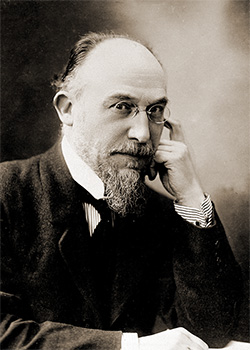Satie - Piano Music
Erik Satie

Erik Satie (1866-1925) was a highly original French composer, a musical outsider of the late 19th and early 20th centuries. Best remembered for his eccentric qualities and for several groups of successful piano pieces, he was undoubtedly an important figure in the French avant-garde of his period. He inspired and supported Debussy and Ravel, and supplied ideas to many movements in music and other arts throughout the 20th century. He also left a substantial body of writings. Satie began taking piano lessons as a child, but was clearly no musical prodigy. He entered the Paris Conservatory at age thirteen, but his teachers found him lacking in talent and he was sent home without an exam. After another three years he was readmitted, but as he didn’t fare much better this time he decided to join the army. However, Satie couldn’t bear military life and managed to make himself ill to get relieved from duty. In 1887 he left home and started living a bohemian life in the artist quarters of Montmartre. He befriended Debussy and Ravel, and became the official composer and chapel-master of the very obscure Rosicrucian Order, led by the novelist Joséphin Péladan. His only love affair, with the model, painter and former trapeze artiste Suzanne Valadon, went on during six months in 1893. Satie wanted Valadon to marry him after their first night together, but she only agreed to move to a house next to his.
By 1896 Satie had no money left, and he had to move to smaller lodgings and then to the suburbs. He started working as a cabaret pianist, which at least gave him a substantial income - but he wasn’t satisfied and decided to resume musical study. Aged 39, he enrolled in Vincent d´Indy’s Schola Cantorum, where he made up for his lost education by exploring classical counterpoint for the next five years. Whether or not because of these academic exercises, from 1912 his career took off and he had much success with his new miniature, humoristic pieces. These later works all have very odd titles, and are full of bizarre instructions and commentaries printed in the score. The eccentric Satie was also a lone wolf: at the time of his death in 1925, absolutely nobody else had ever entered his room since he had moved there twenty-seven years earlier. They found in his wardrobe 84 identical handkerchiefs, 12 identical velvet costumes and dozens of umbrellas, as well as many previously unknown compositions.
Notable works for piano:
3 Gymnopédies
6 Gnossiennes
Dances Gothiques
Embryons Desséchés (Dried up embryos)
3 Véritables Préludes Flasques; pour un chien (3 Genuine Flabby Preludes; For a Dog)
3 Morceaux en forme de Poire (3 Pear-shaped Pieces)
Sonatine Bureaucratique
Vexations (a single page of music to be performed 840 times in succession)
Quote – "What I am":
Everyone will tell you I am not a musician. That is correct. From the very beginning of my career I class myself a phonometrographer. My work is completely phonometrical. Take my Fils des Étoiles, or my Morceaux en forme de Poire, my En habit de Cheval or my Sarabandes - it is evident that musical ideas played no part whatsoever in their composition. Science is the dominating factor. Besides, I enjoy measuring a sound much more than hearing it. With my phonometer in my hand, I work happily and with confidence. What haven´t I weighed or measured? I´ve done all Beethoven, all Verdi, etc. It´s fascinating. The first time I used a phonoscope, I examined a B flat of medium size. I can assure you that I have never seen anything so revolting. I called in my man to show it to him.
On my phono-scales a common or garden F sharp registered 93 kilos. It came out of a fat tenor whom I also weighed.
Satie Piano Sheet Music
for digital devices or to download & print
Total pieces by Satie: 51
ID:66